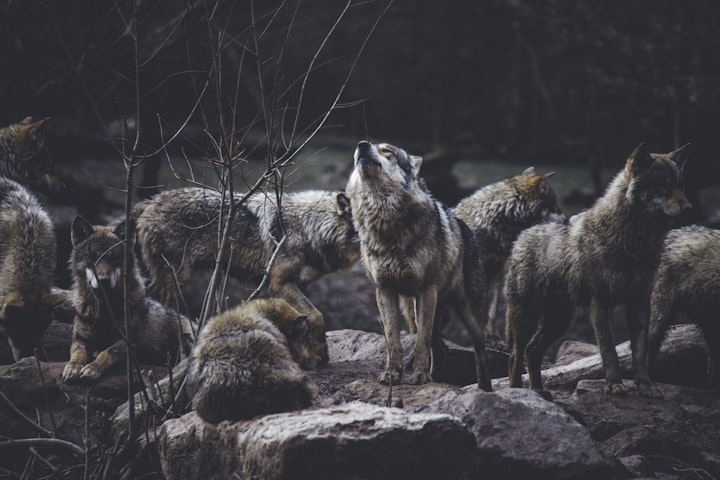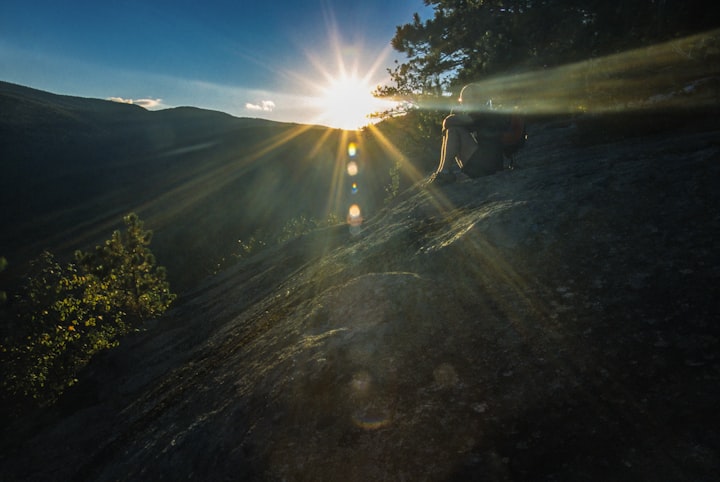The Adolphus’ Plight
Wolves have a bad reputation but they truly are wonderful creatures that should be adored not feared.

Wolves have an atrocious reputation amongst the human population. People don’t understand why exactly we, and other creatures, need them around. Granted, they aren’t the sweetest creatures to roam the earth, but that’s what evolution intended for them. Wolves are extraordinary creatures, they play a key role in balancing out the ecosystem in which they live, they were killed off by people, and yet, the ecosystems they were taken from weren’t saved. Wolves shouldn’t be eradicated, they should be saved.
For people to understand why wolves are important, we must first know them. Wolves are fascinating creatures, so much so, that they have their own culture. A wolves’ family, or pack, has its own hierarchy: Alphas, Betas, Mid-Rankers, and Omegas. The size of a pack will vary in number, pending on the region, season, and prey.. A pack may just consist of the two parents with their offspring, or it may be an extended family, and may include some ‘adoptees’. A wolf pack can have only 2 wolves, or they can consist of over twenty. “When we look at wolves, we are looking at tribes-extended families, each with its own homeland, history, knowledge, and indeed, culture.” (Living with Wolves). These animals are highly intelligent, devoted to their pack, caring, complex, and playful.
Wolves communicate to each other via vocalizations, body language, and scent. Vocalizations include various howls, growls, whines and whimpers, as well as barking. The position a wolf’s body is in can reveal many things. Posture and the tail say a lot, pending if it is dominant or submissive. They can also commune with facial expressions. Because of their many scent glands, wolves naturally use scent as a communicator; scent rolling, scent marking, and following the scent.
There are four wolf species, and many subspecies. The four main wolves are the Gray Wolf, the Arctic Wolf, the Mexican Wolf, and the Red wolf. Wolves are of the Canidae Family, since they are dog-related. Dogs are the descendents of earlier wolves. Wolves are the dogs that refused to be domesticated, (Living with Wolves).
Wolves’ hunts are coordinated efforts, with collaboration, cooperation, intelligence, and teamwork. In a hunt, the wolves seek out the prey that is most vulnerable, whether it be ill, injured, old or young, genetically inferior, or to slow. Being endurance predators, wolves may chase their prey until they find the right opportunity. Each wolf has its own role in the hunt, their role is often based upon gender, social standing, and age. (Living with Wolves). Wolves generally hunt ungulates; elk caribou, deer, and moose.
“A Keystone Species is a plant or animal that plays a unique and crucial role in the way an ecosystem functions. Without a Keystone Species, the ecosystem would be dramatically different or cease to exist altogether.” (Nat’l Geographic). A Keystone Species can be a predator, prey, or even a plant. Keystone Species give their ecosystems balance, without them, their region would face many changes. Since many species rely on them for their own survival, those species would eventually disappear or go extinct in that region. New species may pour in, pushing out the native species. Robert T. Paine, a zoology professor, was the first to establish the theory that ecosystems relied upon Keystone Species for balance.
Wolves, being both an apex predator and one of the Keystone Species’, are extremely paramount to their ecosystems; as seen in Yellowstone National Park. Wolves both directly and indirectly affect their ecosystems. They influence their prey, their prey influences the plant and animal species beneath them, and so forth down the chain. Wolves alter the population, distribution, and behavior of their prey. The wolves’ influence upon their ecosystem is so vast, that they contribute part in changing landscapes.
The war against man and wolf has gone on for hundreds of years. Native Americans had rituals and legends involving this creature, they were portrayed as ferocious warriors, or even thieving spirits. Europeans, with their lack of creativity, simply loathed them. Due to the Europeans’ ignorance, the gray wolf was almost eliminated from the U.S. by 1950. People believed that the wolf posed a great threat to their livestock, this brought on a centuries-long extermination campaign. (Wolf Wars; PBS). Man and Wolf were two of the world’s top predators, so they naturally avoided each other due to fear. However, the hungry wolf soon realized that the livestock of the Europeans made a scrumptious and easy meal. Once the people discovered that their livelihoods were in danger, they hunted the wolves. Ensuring that wolves would be exterminated, the people killed them off, as well as passed down stories about the monster for generations. (Wolf Wars; PBS).
In time, wolf hunting became a profession, a hobby, a sport. People hunted them, they baited them, they took them from their dens, they poisoned them. Wolves became a commodity.
During the late 19th Century, wealthy livestock owners, with their increased power, convinced and demanded that the federal government destroy the enemy. “Stockowners complained that their land was infested with wolves, calling them ‘breeding grounds.’” (Wolf Wars; PBS). In 1906, the Bureau of Biological Survey basically became a wolf-extermination unit.
This government sanctioned extermination nearly killed all of the wolves in the lower forty-eight states, by the middle of the 20th Century. Only small populations remained. Yet, anti-wolf propaganda continued on as late as 1940. The wolf hatred continued on until the late sixties, when people began understanding natural ecosystems, this realization calmed the war on wolves.
“In 1973, Congress gave gray wolves protection under the Endangered Species Act.” (Wolf Wars; PBS). Wolf populations have increased since then, however, they will probably never fully recover. From 1995 to 1996, thirty-one Canadian gray wolves were released into Yellowstone National Park’s wilderness. Ignorance among the human population still remains, so much so, that a hunter killed one of these reintroduced wolves; Wolf Number 10.
During the extermination period, wolves were no longer apart of Yellowstone. This National park was without wolves for sixty-nine years, 1926-1995. The number of Coyotes grew, however, they couldn’t sustain the ecosystem the ways wolves did. “The lack of carcasses left behind by wolves reduced the food traditionally available for foxes, badgers, raptors, coyotes, and other scavengers.” (Living with Wolves).
Elk became to populated, they began damaging their own habitat. They no longer had to stay on the move, meaning they could settle in one area. With the overpopulation of elk, the flora, like Aspen, began to not effectively regenerate itself. Due to the lack of vegetation growth, various species declined as well.
“Since reintroduction, there is evidence that they are restoring stability.” (Living with Wolves). The population in elk and coyotes diminished. Elk returned to their natural behavior of seeking out dense cover or high ground. Coyotes were chased or killed off by the wolves, allowing small prey and mid-level carnivores to resurge. Aspens and other vegetation resumed their natural growth. Beaver numbers grew, which brought on a chain reaction of its own. With the return of wolves, scavengers were fed from the carcasseses of the wolves’ meals.
Even though some people are blinded by ignorance, wolves are an indispensable animal. Many people fear wolves, even though North America has only had two people killed by wolves in the last 100 years. Some say that they’re killing livestock, when in reality, wolves are responsible for less than one percent of all livestock deaths. Some people may argue that wolves aren’t vital, when the evidence clearly depicts that they are. Many people believe that killing wolves will make things better, but what they don’t realize is that, killing wolves creates smaller packs, and smaller packs must go after easier prey: livestock.
Many people don’t realize that we need wolves. Wolves are majestic creatures, that keep their ecosystem balanced. Wolves strengthen the species of their prey, they improve Riparian Areas, they feed other animals, decrease coyote populations, avoid people, and even boost Ecotourism. Wolves do so much for their ecosystem, and yet, they are still seen as if they are the root of all evil. Wolves shouldn’t be terminated for trying to feed themselves. They shouldn’t be persecuted for trying to eat, when people dwindled their packs and original food sources. Without wolves, an ecosystem will eventually die. Wolves are crucial to their ecosystem’s survival.
Work Cited Page:
"HOME: LWW - Living With Wolves". Living with Wolves. N. p., 2016. Web. 11 Feb. 2017. (used many parts of this website)
"The Wolf That Changed America | Wolf Wars: America's Campaign To Eradicate The Wolf | Nature | PBS". Nature. N. p., 2008. Web. 11 Feb. 2017.
Society, National and National Society. "Keystone Species". National Geographic Society. N. p., 2011. Web. 11 Feb. 2017.
About the Creator
Bryttnie Chaffin
Writing things that are fun and/or have powerful emotion behind it, maybe some educational things. Writing about my personal feelings, those of others (real or fictional), or just fun things that my mind makes up. Thanks for reading.






Comments
There are no comments for this story
Be the first to respond and start the conversation.